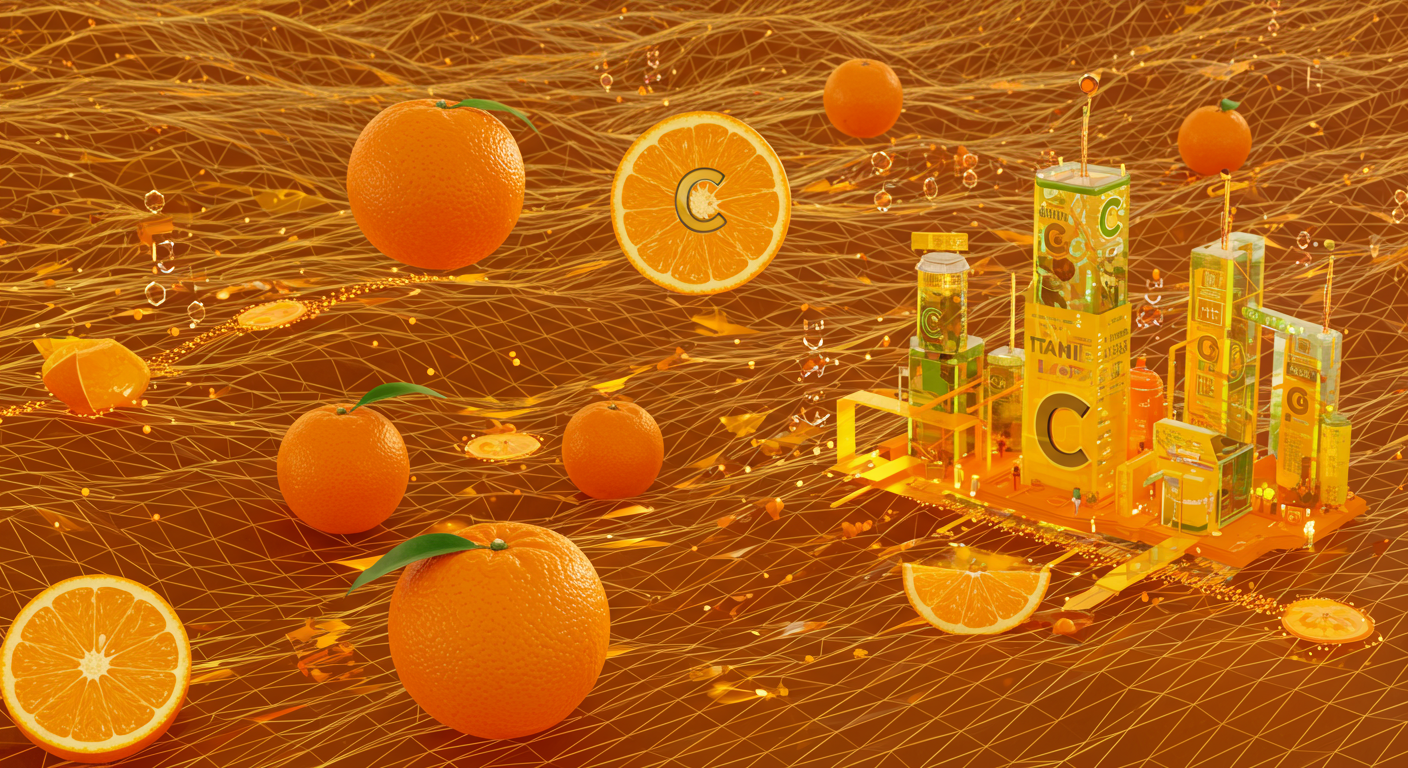
John: Welcome back to the blog, everyone. Today, we’re diving deep into a topic that feels both timeless and more relevant than ever: Vitamin C. For decades, it’s been the go-to nutrient for wellness, but the landscape has evolved significantly. We’re not just talking about staving off the sniffles anymore; we’re talking about a comprehensive “Vitamin C and Citrus Lifestyle.” It’s an approach that integrates diet, smart supplementation, and a deeper understanding of what this essential nutrient does for our bodies.
Lila: I’m glad we’re covering this, John. I was in the health aisle the other day, and it was overwhelming. There are bottles that say “Ester-C,” “Liposomal,” “1000mg,” “with Bioflavonoids”… it feels like you need a chemistry degree just to buy a vitamin. When people hear “Vitamin C,” they probably just picture an orange, right? But it’s clearly so much more complex now.
John: That’s the perfect place to start. That image of an orange is the foundation, but modern science has built a skyscraper on top of it. The “Vitamin C and Citrus Lifestyle” is about understanding that entire structure. It’s about harnessing the power of Vitamin C not just from a bottle, but from your plate, and choosing the right form of supplement for your specific needs, whether that’s for immune support, skin health, or overall vitality. Let’s break it all down, starting with the absolute basics.
The Foundation: What is Vitamin C and Why Is It Truly Essential?
John: At its core, Vitamin C, or ascorbic acid, is a water-soluble vitamin. The most critical fact to remember is that it’s “essential.” In nutritional terms, this means our bodies cannot produce it on their own. We have to obtain it through our diet or supplementation, every single day. Unlike some other animals, humans lost the ability to synthesize Vitamin C millions of years ago, so we are entirely dependent on external sources.
Lila: Okay, “essential” makes sense. But why? What is it actually *doing* in our bodies that’s so important? Most of the marketing I see just shouts “immune support!” Is that the whole story?
John: The immune support claim is valid, and we’ll certainly get into that, but it’s only one chapter of a much larger book. Vitamin C is a multi-talented workhorse. Firstly, it is a powerful antioxidant. Think of it as your body’s cellular bodyguard. Throughout our day, our bodies generate unstable molecules called free radicals due to things like metabolism, pollution, and sun exposure. These free radicals can damage cells, proteins, and DNA in a process called oxidative stress. Vitamin C neutralizes these free radicals, protecting cells from damage.
Lila: So it’s like cellular rust-proofing. What else is on its resume?
John: Its next major role is in collagen synthesis. Collagen is the most abundant protein in our bodies. It’s the structural scaffolding that holds everything together—our skin, bones, cartilage, tendons, and blood vessels. Vitamin C is an indispensable cofactor for the enzymes that produce and stabilize collagen. Without enough Vitamin C, this entire process grinds to a halt. This is why a severe deficiency, known as scurvy, leads to symptoms like bleeding gums, poor wound healing, and joint pain—the body’s structures are literally failing.
Lila: That really puts the “healthy, natural glow” claim I see on some products into perspective. It’s not just a superficial thing; it’s about the fundamental health of your skin’s structure. And you mentioned one other thing?
John: Yes, iron absorption. Specifically, it helps with the absorption of non-heme iron, which is the type of iron found in plant-based foods like beans, lentils, and spinach. For vegetarians, vegans, or anyone looking to boost their iron levels, pairing iron-rich foods with a source of Vitamin C can make a significant difference in how much iron the body can actually use. So, a simple squeeze of lemon on a spinach salad isn’t just for flavor; it’s a brilliant nutritional strategy.
The Power Couple: Vitamin C and Citrus Bioflavonoids

Lila: Okay, I’ve noticed so many supplement bottles, like the ones from American Health or Codeage, don’t just say “Vitamin C.” They specifically advertise “with Citrus Bioflavonoids.” What exactly are those? Are they a type of Vitamin C?
John: That’s an excellent and very common question. No, bioflavonoids are not Vitamin C, but they are its natural partners. Bioflavonoids are a large class of phytonutrients, which are beneficial compounds found in plants. In nature, especially in citrus fruits, Vitamin C rarely exists in isolation. It’s part of a complex that includes these bioflavonoids. Think of them as Vitamin C’s entourage.
Lila: An entourage! I like that. So what do they do? Are they just there for the ride, or do they have a job?
John: They have several important jobs. Like Vitamin C, many bioflavonoids are potent antioxidants themselves, so they add to the overall protective power. But the primary theory behind including them in supplements is synergy. It’s believed that bioflavonoids help the body to absorb and utilize Vitamin C more effectively. Some research suggests they may even protect Vitamin C from being oxidized in the body, essentially extending its lifespan and activity.
Lila: So when a supplement like Nature’s Answer includes “Citrus Bioflavonoids” and “Rose Hips,” it’s trying to mimic the way we’d find Vitamin C in nature? It’s not just a single, isolated molecule but a whole nutritional package.
John: Precisely. Rose hips, for example, are one of the richest natural sources of Vitamin C and also contain a host of bioflavonoids. The goal of these formulations is to provide a more holistic, well-balanced supplement. While the scientific community is still quantifying the exact percentage of increased absorption, the principle is sound and based on nutritional common sense: nutrients often work best as a team, just as they are found in whole foods.
Lila: It feels more intuitive. An orange is more than just ascorbic acid; it has fiber, water, and, as I’m learning, these bioflavonoids. It makes sense that a supplement trying to provide optimal benefits would include these companion compounds.
John: Exactly. It shifts the thinking from just delivering a single chemical to delivering a more complete nutritional complex. This combination is a cornerstone of the “Vitamin C and Citrus Lifestyle”—recognizing that the whole is often greater than the sum of its parts.
Decoding the Supplement Aisle: Forms, Dosages, and What to Look For
John: Now, let’s wade into that confusing aisle you mentioned, Lila. Understanding the different forms of Vitamin C is key to choosing the right product for your body and your lifestyle. Not all Vitamin C is created equal in terms of its formulation and delivery system.
Lila: Okay, lead the way. Let’s start with the basics. I see standard tablets, capsules, and then the more “fun” stuff like chewables and drops. Does the form actually impact how it works?
John: It can, mostly in terms of convenience, user experience, and sometimes absorption speed. Let’s break them down.
Tablets and Capsules: These are the most traditional and widespread form. They are cost-effective, have a long shelf life, and provide a precise, pre-measured dose. For many people, this is all they need. The main drawback is that some people find swallowing larger pills difficult.
Chewable Tablets: Products like the Airborne chewables are popular for a reason. As their marketing points out, they are “convenient and easy for adults and for kids 12+ to take.” They often come in “refreshing, Citrus flavored” options, making them more palatable. The key here is to check the label for added sugars or artificial sweeteners, as these can vary widely between brands.
Vitamin C Drops: Think of brands like HALLS. Their products are often marketed as a “great immune system support.” They are fantastic for on-the-go use and can have a soothing effect on a scratchy throat. Again, be mindful of the sugar content. While they provide a good dose of Vitamin C, they can sometimes be more like a medicated candy.
Liquid and Powdered Vitamin C: Liquids, like the one from Nature’s Answer, and powders are highly versatile. You can mix them into water, juice, or smoothies. This is a great option for those with difficulty swallowing pills or for those who want to avoid the fillers and binders sometimes found in tablets. Some proponents argue that liquids are absorbed more quickly, though the overall bioavailability compared to a standard tablet that dissolves properly might not be significantly different.
Lila: That’s a great overview of the standard options. But what about the ones that sound like they’re from a science fiction movie? I’m talking about “Ester-C” and “Liposomal Vitamin C.” They’re usually more expensive. Are they worth it?
John: This is where supplementation gets really interesting. These are advanced formulations designed to solve specific problems. Let’s start with Ester-C.
As the product descriptions from American Health and Vitamin Shoppe highlight, Ester-C has two primary, heavily researched benefits. First, it is a **non-acidic formula that’s gentle on the stomach.** Standard ascorbic acid is, as the name implies, acidic. For some people, especially at higher doses, this can cause stomach irritation or heartburn. Ester-C is a patented form of calcium ascorbate, which has a neutral pH. This makes it a fantastic choice for anyone with a sensitive digestive system.
The second major claim is **24-hour immune support.** This is based on research showing that Ester-C contains Vitamin C metabolites—compounds that are formed when Vitamin C breaks down. These specific metabolites, particularly threonate, are believed to help the Vitamin C get into cells more easily and stay in the body’s white blood cells for longer, up to 24 hours. This is a significant advantage over standard ascorbic acid, which is typically flushed out of the body within a few hours.
Lila: So with Ester-C, you’re getting a gentler form that also potentially works longer in your immune cells. That sounds like a big upgrade. What about Liposomal C?
John: Liposomal technology is another step up, focused purely on maximizing absorption. As seen with brands like Codeage and Zooki, this form involves encapsulating the Vitamin C molecules inside liposomes, which are microscopic spheres made of phospholipids—the same material that makes up our cell membranes.
This fatty bubble serves two purposes. It protects the Vitamin C from being degraded by the harsh environment of the digestive system. Then, because the liposome is made of the same material as our cells, it can fuse with the cell wall and deliver the Vitamin C directly inside the cell. The result is significantly higher bioavailability, meaning more of the vitamin gets into your bloodstream and your cells compared to a standard, un-encapsulated form. This is why you’ll see claims of “4x Higher Absorption.” It’s a premium option for those looking for maximum impact from their supplement.
Lila: That makes perfect sense. So, with all these forms, there’s the question of dosage. The numbers are all over the place. I see 1000mg, 1500mg, and the HALLS drops mention they have “150 percent daily value of vitamin C per serving.” What’s the right amount?
John: This is a crucial point of confusion. There’s a big difference between the amount needed to prevent deficiency and the amount used for optimal health benefits. The Recommended Dietary Allowance (RDA) is about 90mg for adult men and 75mg for adult women. This is the minimum amount needed to prevent scurvy. The “Daily Value” you see on labels is based on this.
However, the higher doses you see in supplements—typically 500mg to 2000mg—are used for therapeutic or optimal wellness purposes, such as providing robust antioxidant support and bolstering the immune system during times of stress. Doses like 1000mg are extremely common and are what many practitioners recommend for daily support. The body’s demand for Vitamin C also increases during illness or periods of high stress. The Tolerable Upper Intake Level (UL) for adults is set at 2,000mg per day. Going above that doesn’t usually cause serious harm, but it can lead to digestive distress like diarrhea and stomach cramps as the body works to excrete the excess.
Lila: And what about all the other ingredients I see? The Codeage supplement has zinc, elderberry, and quercetin. The product from Diligence Healthcare combines Vitamin C with Zinc. Are these just marketing fluff?
John: Not at all. These are synergistic additions designed to create a more comprehensive formula, usually targeted at a specific benefit like immunity.
Zinc is a classic partner for Vitamin C. It’s a mineral that is absolutely critical for the development and function of immune cells. Combining **Vitamin C 1000mg and Zinc 10mg**, as one product does, creates a potent one-two punch for immune health.
Elderberry, Quercetin, and Rose Hips are all powerful plant-based compounds. Elderberry has a long history in traditional medicine for supporting the immune system. Quercetin is a bioflavonoid known for its anti-inflammatory and antioxidant properties. And as we discussed, Rose Hips are a natural source of both Vitamin C and other bioflavonoids. Including these creates a multi-faceted supplement that provides a broader spectrum of immune-supporting and antioxidant compounds.
The Lifestyle in Practice: Beyond the Pill

John: We’ve spent a lot of time on supplements, but now we arrive at the most crucial part of the “Vitamin C and Citrus Lifestyle.” Supplements are intended to *supplement* a healthy diet and lifestyle, not replace them. You cannot out-supplement a poor diet or unhealthy habits.
Lila: Right, the magic pill fallacy! So even if I’m taking the most advanced Liposomal Vitamin C, I still need to be eating my fruits and veggies. Where should people start if they want to get more Vitamin C from their food?
John: Absolutely. And the great news is that it’s delicious and easy. The common knowledge is correct: **citrus fruits like oranges and lemons are loaded with Vitamin C.** As health articles and even a ResearchGate study point out, determining the **Vitamin C content in citrus fruits** shows they are true nutritional powerhouses. An average-sized orange provides a significant portion of your daily RDA. But don’t stop there. The citrus family is diverse and wonderful:
* **Grapefruit:** A fantastic source, but be aware it can interact with certain medications, so check with your doctor.
* **Lemons and Limes:** While you might not eat them whole, squeezing them into water, over salads, or on fish is an easy way to add a significant boost. They are **rich in Vitamin C, a vital nutrient for strengthening the immune system.**
* **Tangerines and Clementines:** These are easy to peel and perfect for a quick, healthy snack.
Lila: I think many people would be surprised to learn where else Vitamin C is hiding. It’s not just in citrus, is it?
John: Not at all. In fact, some non-citrus foods are even more concentrated sources. This is where dietary diversity really pays off. Some of the top champions include:
* **Red Bell Peppers:** A single cup of chopped red bell pepper contains nearly three times more Vitamin C than an orange.
* **Kiwifruit:** These fuzzy green fruits are packed with Vitamin C.
* **Strawberries and Blackcurrants:** Berries are antioxidant goldmines, and they deliver a healthy dose of Vitamin C.
* **Broccoli and Brussels Sprouts:** These cruciferous vegetables are excellent sources, especially when eaten raw or lightly steamed.
* **Papaya and Mango:** As the research paper we saw mentioned, these non-citrus tropical fruits are also excellent sources.
Lila: So, a “Vitamin C showdown,” as one social media post put it, might have a surprising winner! It could be a bell pepper, not an orange. How does this translate into daily life? How can we apply this lifestyle for that “skin brightening” effect everyone talks about?
John: The application is two-fold: internal and external. Internally, by consuming a diet rich in these foods and using a good quality supplement, you are providing your body with the building blocks for collagen. This strengthens the skin from within, improving elasticity and resilience. This consistent internal nourishment is what leads to that “healthy, natural glow” people notice. The antioxidant properties also help protect the skin from damage caused by the sun and environmental pollutants.
Externally, Vitamin C is a star ingredient in skincare. Topical serums containing Vitamin C can provide a more direct antioxidant benefit to the skin, helping to brighten the complexion and reduce the appearance of dark spots. So, a true Vitamin C lifestyle can involve both eating it and applying it!
Making an Informed Choice: Your Personal Vitamin C Strategy
John: We’ve covered a vast amount of ground, from the molecular function of ascorbic acid to the technology behind liposomes and the best food sources. The goal isn’t to make things more complicated, but to empower you to create a personal strategy that fits your needs.
Lila: It’s a lot to process, but it feels much clearer now. So, to wrap it all up, how can someone walk away from this article and confidently choose a path forward? Can you give us a final cheat sheet?
John: Of course. Let’s distill it into a simple decision-making framework based on individual needs:
* **If you have a sensitive stomach or want long-lasting immune support:** Look for a **non-acidic formula like Ester-C**. Its gentle nature and ability to remain in white blood cells for up to 24 hours make it an excellent, well-researched choice.
* **If your primary goal is maximum absorption and potency:** Consider investing in a **Liposomal Vitamin C** supplement. The advanced delivery system ensures more of the nutrient gets into your system, making it ideal for those with high needs or who want the most impact from their dosage.
* **If you prioritize convenience and enjoy a flavorful experience:** **Chewable tablets or vitamin drops** with “assorted delicious fruity citrus flavors” are a perfect fit. They are easy to take on the go and can make your daily supplement routine feel less like a chore. Just be mindful of the sugar content.
* **If you are a purist or on a tighter budget:** A simple, high-quality ascorbic acid tablet, especially one paired **with citrus bioflavonoids**, is a fantastic and effective option. Focus first on building a diet rich in Vitamin C from whole foods, and use this as your reliable backup.
* **If you’re looking for comprehensive immune support:** Choose a formula that combines Vitamin C with other proven ingredients like **Zinc, Elderberry, or Quercetin**. These synergistic blends offer a multi-pronged approach to wellness.
Lila: That’s incredibly helpful. It’s not about finding the single “best” one, but the “best one for me.” What’s the final piece of advice you’d give our readers?
John: The most important advice is always this: knowledge is empowering, but it should be paired with professional guidance. Before beginning any new supplement regimen, especially with higher doses or if you have pre-existing health conditions or are taking medication, please speak with your doctor or a registered dietitian. They can help you tailor this information to your unique health profile. The Vitamin C and Citrus Lifestyle is a powerful tool for health, and by approaching it with intention and knowledge, you can truly make it work for you.
